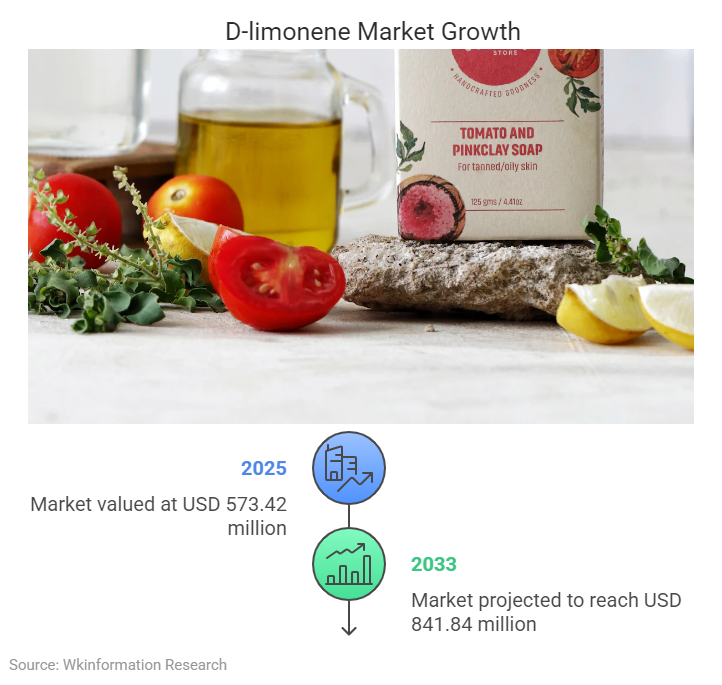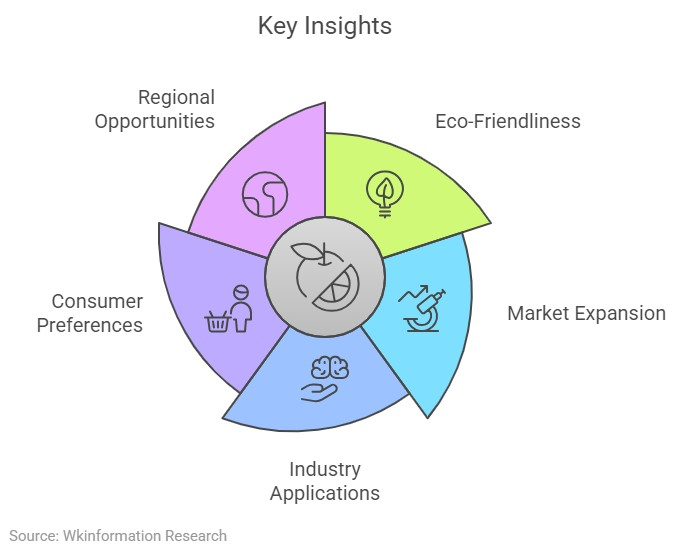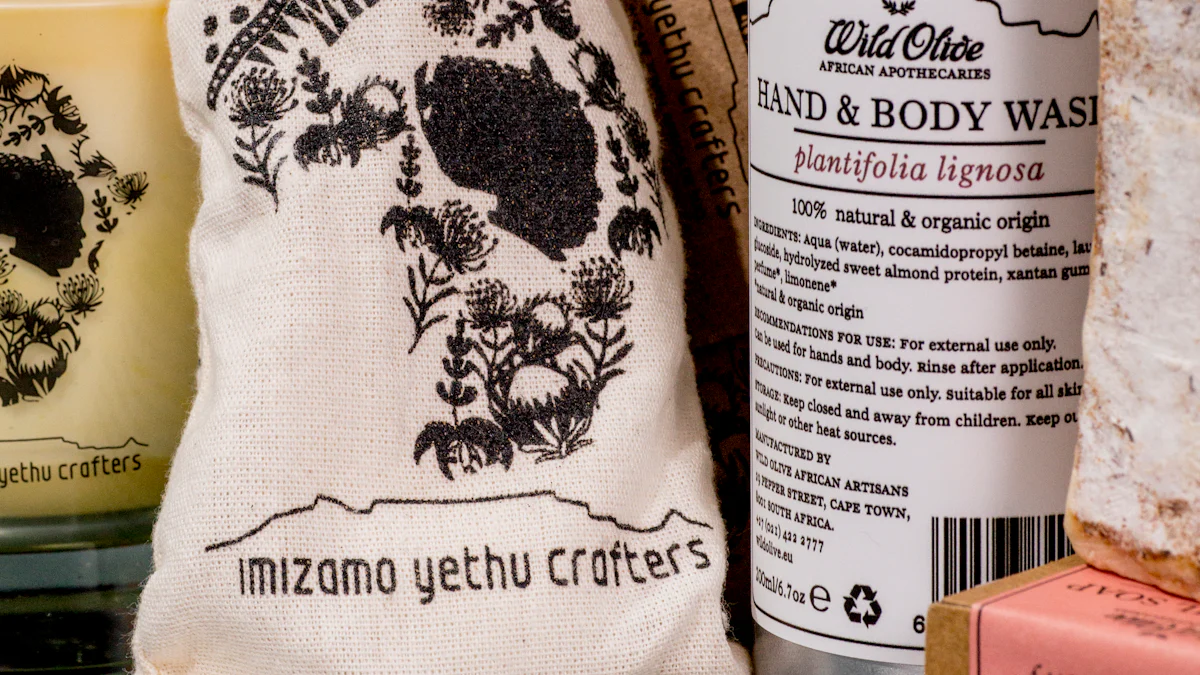
The d-limonene market plays a pivotal role in advancing sustainability and innovation across industries. Derived primarily from citrus fruits, d-limonene offers a natural and eco-friendly alternative to synthetic chemicals. Current trends indicate a growing preference for products that align with environmental values. This shift has fueled demand in sectors such as food and beverages, cosmetics, and cleaning products. The global market, valued at USD 573.42 million in 2025, is projected to reach USD 841.84 million by 2033, growing at a CAGR of 4.92%. Its applications, from natural flavoring to reducing VOC emissions, underscore its importance in fostering a greener future.
Key Insights
- D-limonene comes from citrus fruits and is eco-friendly.
- The global market for d-limonene may grow from $573.42 million in 2025 to $841.84 million by 2033. This is because more people want sustainable products.
- Industries like food, drinks, cosmetics, and cleaning use d-limonene. This shows it can be used in many ways.
- People now prefer natural ingredients, which is changing the market.
- Countries in Asia-Pacific and Latin America offer big chances for growth.

D-limonene Market Overview
Market Size and Growth Rate
The global d-limonene market has witnessed remarkable growth over the past decade. This upward trajectory highlights the increasing demand for natural and sustainable solutions across industries. The market analysis reveals that advancements in extraction technologies and regulatory support for eco-friendly products have significantly contributed to this growth.
The growing preference for natural ingredients and the expansion of applications in sectors like food and beverages, cosmetics, and cleaning products have further fueled this trend. These factors underscore the robust potential of the d-limonene market in the coming years.
Key Drivers of Market Growth
Several factors drive the growth of the d-limonene market. Industries increasingly adopt d-limonene as a natural alternative to synthetic solvents due to its biodegradable nature and low toxicity. Rising environmental concerns and regulatory pressures have amplified this shift. The industrial solvents segment, in particular, has embraced d-limonene for its eco-friendly properties.
Other key drivers include:
- Technological advancements enhancing product efficiency.
- Rising consumer interest in natural and organic products.
- Favorable economic conditions increasing disposable incomes.
- Supportive regulatory environments encouraging sustainable practices.
- Globalization opening new market opportunities.
The emphasis on clean label products and the growing awareness of chemical safety have also played a pivotal role in driving demand for d-limonene.
Role of Sustainability in Market Expansion
Sustainability has become a cornerstone of the global d-limonene market. The demand for natural ingredients across sectors such as food, cosmetics, and cleaning products has surged. D-limonene’s appeal as a natural alternative to synthetic chemicals aligns with the values of eco-conscious companies and health-aware consumers.
Environmentally friendly extraction methods, like cold-pressing, have gained popularity, further enhancing d-limonene’s marketability. The trend toward clean label products and the rising use of essential oils have also contributed to its adoption. Increased consumer awareness of sustainability and product safety continues to propel the market forward, making d-limonene a key player in the transition to greener industries.
D-limonene Market Segmentation
By Source
Citrus Fruits
Citrus fruits serve as the primary source of d-limonene, with oranges leading in production due to their high yield and cost-effectiveness. This source not only ensures economic viability but also supports sustainability by reducing citrus waste. Lemons and grapefruits contribute unique aromatic profiles, making them popular in food, beverages, and cosmetics. Lime and mandarin, though minor contributors, offer specialized blends and niche scent profiles, presenting opportunities for market expansion.
Synthetic Sources
Synthetic sources of d-limonene provide an alternative to natural extraction, especially when citrus supply chains face constraints. These sources ensure consistent quality and availability, though they lack the environmental benefits of citrus-derived d-limonene. The synthetic segment remains limited due to the growing preference for natural and eco-friendly products.
By Grade
Food Grade
Food-grade d-limonene finds extensive use as a natural flavoring agent and preservative. Its antimicrobial properties enhance food safety, while its ability to improve sensory profiles aligns with consumer demand for organic and clean-label products. This grade dominates the d-limonene market, driven by its applications in soft drinks, bakery items, and other consumables.
Industrial Grade
Industrial-grade d-limonene serves as an eco-friendly solvent in cleaning products, paints, and adhesives. Its biodegradable nature and compliance with environmental regulations make it a preferred choice for industrial applications. The demand for this grade continues to grow as industries prioritize sustainability.
By End-User Industry
Food & Beverages
The food and beverage industry represents one of the largest consumers of d-limonene. It is widely used as a natural flavoring agent and preservative, enhancing the taste and shelf life of products like soft drinks, baked goods, and confectionery. Its antimicrobial properties further contribute to its popularity in this sector.
Cosmetics & Personal Care
D-limonene plays a vital role in cosmetics and personal care products as a fragrance enhancer and solvent. It is commonly found in shampoos, lotions, and perfumes, aligning with the clean beauty trend. Its natural origin appeals to eco-conscious consumers seeking sustainable alternatives.
Cleaning Products
The cleaning products industry leverages d-limonene for its effectiveness as a solvent and degreaser. It provides an eco-friendly alternative to petroleum-based solvents, making it a preferred choice for manufacturers aiming to reduce environmental impact.
Pharmaceuticals
In the pharmaceutical sector, d-limonene is valued for its therapeutic properties. It is used to address digestive issues, improve gut health, and explore potential anti-cancer applications. Its natural composition and health benefits make it a promising ingredient in this industry.
Regional Insights on the D-limonene Market

North America
North America holds a prominent position in the global d-limonene market. Several factors contribute to this dominance. The region has witnessed a surge in demand for natural ingredients across industries such as cosmetics, food and beverages, and cleaning products. Consumers increasingly prefer clean-label products, reflecting a broader trend toward eco-friendly and sustainable solutions. Regulatory frameworks in North America further support the adoption of natural products, encouraging manufacturers to incorporate d-limonene into their formulations.
The United States leads the region, driven by advanced technological adoption and a strong focus on sustainability. Canada also plays a significant role, with its growing emphasis on green chemistry and environmentally conscious practices. These factors collectively position North America as a key player in the global d-limonene market.
Europe
Europe’s d-limonene market thrives on its commitment to sustainability and regulatory compliance. The region has a well-established demand for natural and organic products, particularly in personal care, food and beverages, and cleaning products. Stringent environmental regulations in Europe promote the use of natural ingredients, making d-limonene an attractive choice for manufacturers.
Germany, France, and the United Kingdom lead the European market, driven by their robust industrial bases and consumer awareness of eco-friendly practices. Compared to other regions, Europe emphasizes regulatory alignment and sustainability, setting a benchmark for the global market. However, the Asia-Pacific region is growing rapidly due to industrialization and a rising middle class, while North America excels in technological advancements.
Asia-Pacific
The Asia-Pacific region represents a rapidly expanding segment of the d-limonene market. Technological advancements, evolving regulatory frameworks, and increasing consumer demand drive this growth. Key countries such as China, India, Japan, South Korea, and Southeast Asian nations lead the region’s development.
China and India stand out due to their vast populations and expanding industrial sectors. These countries have embraced d-limonene for its applications in food, cosmetics, and cleaning products. Japan and South Korea contribute through technological innovations, enhancing the efficiency and quality of d-limonene-based products. The region’s growth potential remains significant, with its dynamic markets and increasing focus on sustainability.
Latin America
Latin America represents a growing segment of the global d-limonene market. The region benefits from its abundant citrus production, particularly in countries like Brazil and Mexico. Brazil, as one of the largest producers of oranges globally, plays a pivotal role in supplying raw materials for d-limonene extraction. This advantage positions the region as a key supplier to international markets.
The food and beverage industry in Latin America drives significant demand for d-limonene. Manufacturers in the region increasingly use it as a natural flavoring agent and preservative. The cosmetics and personal care sector also contributes to market growth, leveraging d-limonene for its aromatic and eco-friendly properties. Cleaning product manufacturers in the region have adopted it as a sustainable alternative to petroleum-based solvents.
Despite its potential, the Latin American d-limonene market faces challenges. Limited technological advancements in extraction processes and fluctuating citrus yields due to climate variability hinder consistent supply. However, ongoing investments in infrastructure and research aim to address these issues. The region’s focus on sustainability and its vast agricultural resources position it for future growth in the d-limonene market.
Middle East & Africa
The Middle East and Africa region holds untapped potential in the d-limonene market. Citrus cultivation in countries like South Africa, Egypt, and Morocco provides a foundation for d-limonene production. These nations have begun to explore opportunities to expand their presence in the global market.
The cleaning products industry in the region has shown increasing interest in d-limonene due to its effectiveness as a solvent and its eco-friendly nature. Additionally, the food and beverage sector has started incorporating d-limonene as a natural flavoring agent. However, the adoption of d-limonene in the cosmetics and pharmaceutical industries remains limited, presenting opportunities for future growth.
Challenges in the region include underdeveloped infrastructure and limited access to advanced extraction technologies. Political instability in certain areas also impacts the supply chain. Despite these obstacles, the region’s growing awareness of sustainability and its agricultural potential create opportunities for expansion. Governments and private investors are beginning to recognize the value of d-limonene, which could lead to increased production and market participation.
Opportunities and Challenges in the D-limonene Market
Growth Opportunities
Rising Demand for Natural Ingredients
The increasing consumer preference for natural and sustainable products has created significant opportunities in the d-limonene market. Industries such as food and beverages, cosmetics, and cleaning products are shifting toward eco-friendly alternatives. D-limonene, with its natural origin and versatile applications, aligns perfectly with this trend. Its approval as a food additive has further expanded its use as a flavoring agent in various consumables. Additionally, the popularity of aromatherapy has boosted its demand in personal care products. These factors collectively highlight the growing potential for d-limonene producers to cater to environmentally conscious markets.
Expansion in Emerging Markets
Emerging markets present a fertile ground for the growth of the d-limonene industry. Countries in Asia-Pacific, Latin America, and Africa are witnessing a surge in demand for natural ingredients due to rising disposable incomes and changing consumer preferences. D-limonene’s role as an eco-friendly solvent makes it a viable option for industries facing stricter regulations on volatile organic compounds (VOCs). Furthermore, its emerging applications in pharmaceuticals and sustainable packaging solutions, such as biodegradable plastics, offer new avenues for market expansion. Producers can capitalize on these opportunities by investing in infrastructure and forming strategic partnerships in these regions.
Challenges in the Market
Supply Chain Constraints
The d-limonene market faces significant challenges due to its reliance on citrus fruit supply. Volatility in agricultural production, caused by adverse weather conditions, pests, and diseases, directly impacts the availability of raw materials. These disruptions often lead to supply shortages, creating uncertainty for manufacturers. Additionally, external economic factors, such as trade regulations and geopolitical tensions, further complicate supply chain stability. Addressing these constraints requires investments in advanced extraction technologies and diversified sourcing strategies.
Price Volatility of Raw Materials
Price instability remains a critical challenge for the d-limonene market. Fluctuations in citrus fruit yields, driven by climate change and agricultural issues, result in inconsistent pricing. This volatility complicates the ability of manufacturers to maintain stable product costs, affecting both producers and consumers. The heavy dependence on oranges and lemons exacerbates this issue, as any disruption in their supply chain can significantly impact market dynamics. To mitigate these challenges, producers must explore alternative sources and enhance supply chain resilience.
Competitive Landscape of the D-limonene Market
Key Players and Market Positioning
The d-limonene market features a diverse array of key players, each contributing to its growth and innovation. Prominent companies include Merck KGaA, Koninklijke DSM N.V., Citrus and Allied Essences, Ltd., Florida Chemical Company, Renessenz LLC, and BASF SE. These organizations hold significant market shares and maintain strong positions through their extensive product portfolios and global reach.
Other notable participants include Bramha Scientific, Aredale Chemical, Norkem, and Shamrock Chemicals. Companies such as Aroma Aromatics & Flavours and Mentha & Allied Products have also established themselves as reliable suppliers. Additionally, firms like Banner Chemicals, Parchem Fine & Specialty Chemicals, and Seidler Chemical continue to expand their presence in the market. This competitive landscape highlights the dynamic nature of the industry, with both established leaders and emerging players driving innovation.
Strategies and Innovations
Leading companies in the d-limonene market are adopting strategies that emphasize sustainability and innovation. Many firms are investing in research and development to enhance the efficacy and versatility of d-limonene. Hybrid formulations that combine d-limonene with other natural compounds are gaining traction, offering improved performance and broader applications.
Environmental sustainability remains a key focus. Companies are shifting toward biodegradable and low-impact chemicals to meet the rising demand for eco-friendly solutions. Strategic partnerships between producers and end-user industries are also becoming more common. Collaborations with research institutions aim to develop innovative applications, while expanded distribution channels help companies reach new markets. These strategies underscore the industry’s commitment to addressing recent industry trends and consumer preferences.
Recent Developments in the Market
Recent advancements in the d-limonene market demonstrate its evolving nature. In 2022, Merck KGaA increased its production capacity to meet growing global demand. Koninklijke DSM N.V. launched a line of eco-friendly cleaning products in 2021, showcasing the versatility of d-limonene. Citrus and Allied Essences, Ltd. introduced organic-certified d-limonene in 2020, catering to the demand for natural ingredients.
Florida Chemical Company expanded its facilities in 2019 to serve the personal care and fragrance industries. Renessenz LLC acquired a manufacturing facility in 2018, strengthening its market position. Innovations in extraction techniques have improved efficiency and cost-effectiveness, while the incorporation of d-limonene in bio-based plastics has gained momentum. These developments reflect the industry’s adaptability and its focus on sustainability.
Future Outlook for the D-limonene Market

Market Projections and Growth Potential
The d-limonene market is poised for significant growth in the coming years. Analysts predict a steady increase in demand across industries, driven by the global shift toward natural and sustainable products. The market’s valuation, which stood at $573.42 million in 2025, is expected to reach $841.84 million by 2033, reflecting a compound annual growth rate (CAGR) of 4.92%. This growth highlights the increasing adoption of d-limonene as a versatile ingredient in food, cosmetics, and cleaning products.
The food and beverage sector will likely remain a dominant contributor, leveraging d-limonene for its natural flavoring and preservative properties. Meanwhile, the cosmetics industry is expected to expand its use of d-limonene in clean-label formulations. Emerging applications in pharmaceuticals, such as digestive health and potential anti-cancer treatments, also present promising opportunities. These projections underscore the robust potential of the d-limonene market in fostering innovation and sustainability.
Emerging Trends in the D-limonene Market
Several trends are shaping the future of the d-limonene market:
- Increasing consumer preference for natural and organic products.
- Expansion of d-limonene applications in the food and beverage sector.
- Rising demand for eco-friendly solvents as alternatives to petroleum-based options.
- Emerging applications in the pharmaceutical sector.
- Growing popularity of clean-label products and essential oils.
- Emphasis on environmentally friendly extraction methods.
Regulatory support for natural products further accelerates these trends. Companies are also focusing on consumer education to highlight the benefits of d-limonene, ensuring its sustained adoption across industries.
Impact of Sustainability Initiatives
Sustainability initiatives are reshaping the d-limonene market. The demand for natural ingredients has surged in food, cosmetics, and cleaning products, aligning with the values of eco-conscious consumers. D-limonene, derived from citrus peels, offers a sustainable alternative to synthetic chemicals. Cold-pressing extraction methods reduce waste and enhance its appeal in consumer goods.
The trend toward clean-label products and the rising popularity of essential oils have further bolstered the market. Aromatherapy, in particular, has gained traction, with d-limonene playing a key role in this segment. These initiatives not only drive market growth but also position d-limonene as a cornerstone of environmentally friendly practices.
Overview
The d-limonene market continues to thrive, driven by the rising demand for natural ingredients and eco-friendly solutions. Key trends include the growing preference for clean-label products and the adoption of environmentally friendly extraction methods like cold-pressing. Regulatory support for natural solvents further accelerates market growth, positioning d-limonene as a cornerstone of sustainability.
Stakeholders can capitalize on expanding applications in personal care, cleaning products, and pharmaceuticals. Emerging markets in Asia-Pacific and Latin America offer untapped potential, while advancements in extraction technologies enhance product adoption. Strategic partnerships and diversification into industrial applications present additional opportunities for innovation and growth.
| Report Metric | Details |
|---|---|
| Report Name | Global D-limonene Market Report |
| Base Year | 2024 |
| Segment by Type |
· Citrus Fruits · Synthetic Sources |
| Segment by Application |
· Food & Beverages · Cosmetics & Personal Care · Cleaning Products · Pharmaceuticals |
| Geographies Covered |
· North America (United States, Canada) · Europe (Germany, France, UK, Italy, Russia) · Asia-Pacific (China, Japan, South Korea, Taiwan) · Southeast Asia (India) · Latin America (Mexico, Brazil) |
| Forecast units | USD million in value |
| Report coverage | Revenue and volume forecast, company share, competitive landscape, growth factors and trends |
FAQ
What is d-limonene, and where does it come from?
D-limonene is a natural compound primarily extracted from citrus fruit peels, such as oranges and lemons. It is a terpene with a pleasant citrus aroma, widely used in food, cosmetics, cleaning products, and pharmaceuticals due to its eco-friendly and versatile properties.
Why is d-limonene considered eco-friendly?
D-limonene is biodegradable and derived from renewable sources like citrus peels, which are often byproducts of the juice industry. Its production reduces waste and replaces synthetic chemicals, aligning with sustainability goals and environmental regulations.
Which industries benefit the most from d-limonene?
Industries such as food and beverages, cosmetics, cleaning products, and pharmaceuticals benefit significantly. D-limonene serves as a natural flavoring agent, solvent, and preservative, making it a versatile ingredient for various applications.
What challenges does the d-limonene market face?
The market faces challenges like supply chain disruptions due to fluctuating citrus yields and price volatility of raw materials. Climate change, pests, and diseases also impact production, creating uncertainties for manufacturers.
How does sustainability impact the future of the d-limonene market?
Sustainability drives demand for d-limonene as industries prioritize natural and eco-friendly solutions. Its role in reducing waste and replacing synthetic chemicals positions it as a key ingredient in the transition to greener practices across multiple sectors.
Global D-limonene Market Report (Can Read by Free sample) – Table of Contents
Chapter 1: D-limonene Market Analysis Overview
- Competitive Forces Analysis (Porter’s Five Forces)
- Strategic Growth Assessment (Ansoff Matrix)
- Industry Value Chain Insights
- Regional Trends and Key Market Drivers
- D-limoneneMarket Segmentation Overview
Chapter 2: Competitive Landscape
- Global D-limoneneplayers and Regional Insights
- Key Players and Market Share Analysis
- Sales Trends of Leading Companies
- Year-on-Year Performance Insights
- Competitive Strategies and Market Positioning
- Key Differentiators and Strategic Moves
Chapter 3: D-limonene Market Segmentation Analysis
- Key Data and Visual Insights
- Trends, Growth Rates, and Drivers
- Segment Dynamics and Insights
- Detailed Market Analysis by Segment
Chapter 4: Regional Market Performance
- Consumer Trends by Region
- Historical Data and Growth Forecasts
- Regional Growth Factors
- Economic, Demographic, and Technological Impacts
- Challenges and Opportunities in Key Regions
- Regional Trends and Market Shifts
- Key Cities and High-Demand Areas
Chapter 5: D-limonene Emerging and Untapped Markets
- Growth Potential in Secondary Regions
- Trends, Challenges, and Opportunities
Chapter 6: Product and Application Segmentation
- Product Types and Innovation Trends
- Application-Based Market Insights
Chapter 7: D-limonene Consumer Insights
- Demographics and Buying Behaviors
- Target Audience Profiles
Chapter 8: Key Findings and Recommendations
- Summary ofD-limonene Market Insights
- Actionable Recommendations for Stakeholders


